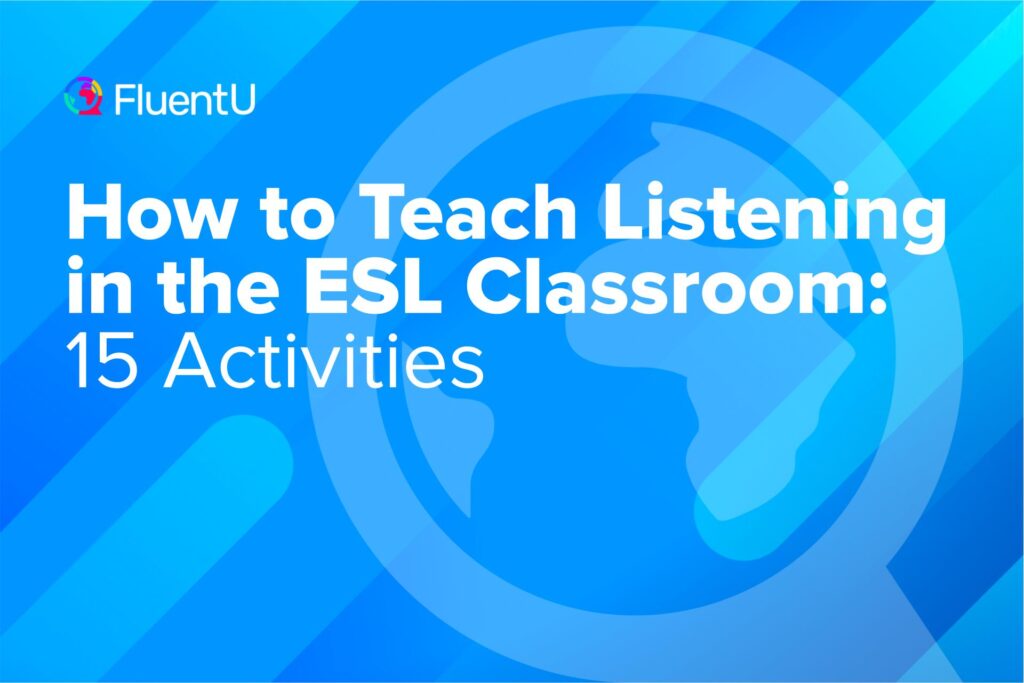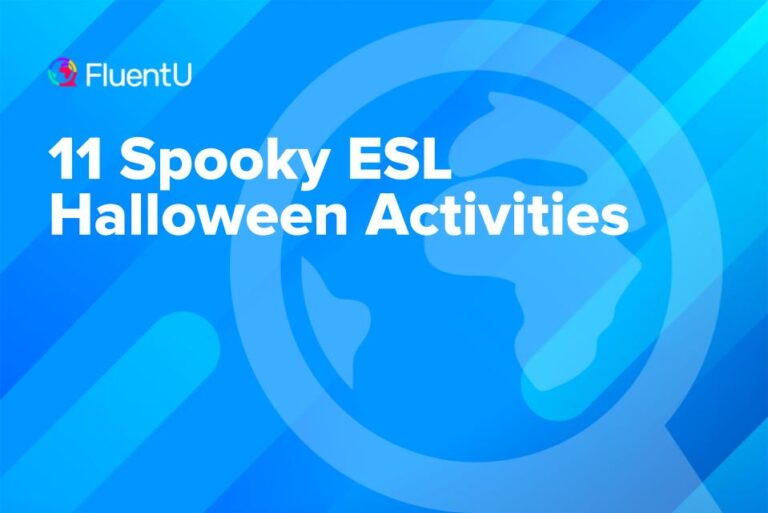How to Teach Listening in the ESL Classroom: 15 Activities

Teaching listening skills can be tricky, as all students learn at different paces. Some students will “get it,” others may struggle… and what if a student is hard of hearing?
In this post, I’ll discuss how to teach listening skills in the classroom, including methods to improve your students’ listening and confidence, and activities you can do with them to improve their skills overall.
Download: This blog post is available as a convenient and portable PDF that you can take anywhere. Click here to get a copy. (Download)
How to Increase Listening Skills and Confidence
First of all, here are three basic principles.
Limit the use of translation.
Translation is a habit that needs to be limited because…
- Students tend to start to panic when they find they don’t know every word.
- Using those electronic translators especially can give warped ideas of meaning.
This doesn’t mean that you never let them translate. Sometimes having an equivalent from their first language is the only way to move them forward, but quickly move on and don’t allow them to keep returning to it.
When students hear a new word or expression, they need something to tie it to. As their teacher, you can help them with this by providing…
- Context: Help them to find clues to the meaning in the context of the listening “text.”
- Pictures: Show them a picture so that when they hear the word or expression again later, the picture will come to mind.
- Action: Get them to perform an action so that when they hear the word or expression again later, they will remember that particular action.
- English synonyms or antonyms: Their understanding of English will grow by leaps and bounds if they can explain an English word with other English words. Encourage (and guide) them to look up unknown words in an English dictionary.
Avoid confusing listening skills with literacy skills.
When you first introduce a new listening “text” (e.g., video, story, song, podcast…) concentrate on listening and don’t provide subtitles or written script (yet).
The reasons for this are as follows:
- Firstly, we don’t want students with poor literacy skills to be disadvantaged in learning the listening skill.
- Secondly, students who are confidently literate often want to be able to see and read the words while they are listening, but this would rob them of the opportunity to really listen.
- Thirdly, as mentioned above, it can be a real confidence booster when they discover just how much they do understand without any other help.
Once they have listened without seeing subtitles or script the first time, and you have discussed some issues, then you can listen and watch again with the assistance of subtitles or text.
Use videos because students can watch and listen.
We want to prepare our students to take part in conversations. A large part of that listening involves reading a speaker’s facial expressions and body language, which can vary from culture to culture. So, most of the time, your students need to practice their “listening” skills by watching videos, or watching you talk or tell stories.
You could use FluentU to give students a leg up in this challenge.
It uses a natural approach that helps you ease into the English language and culture over time. You’ll learn English as it’s spoken in real life.
FluentU has a variety of engaging content from popular talk shows, nature documentaries and funny commercials, as you can see here:

FluentU makes it really easy to watch English videos. There are captions that are interactive. That means you can tap on any word to see an image, definition and useful examples.

For example, when you tap on the word "searching," you'll see this:

Learn all the vocabulary in any video with quizzes. Swipe left or right to see more examples for the word you’re learning.

The best part is that FluentU keeps track of the vocabulary that you’re learning and gives you extra practice with difficult words. It even reminds you when it’s time to review! Every learner has a truly personalized experience, even if they’re learning with the same video.
Start using the FluentU website on your computer or tablet or, better yet, download the FluentU app from the iTunes or Google Play store. Click here to take advantage of our current sale! (Expires at the end of this month.)

Pre-listening Activities
Predicting and guessing
In normal conversation, what we hear tends to fit in with what we expect to hear, and without necessarily thinking about it we tend to listen for specific details.
It’s telling that when someone says something totally unexpected or out of context, many people respond in surprise with “What?!” as if they didn’t actually hear the words. While listening to people we are familiar with in a particular context, we can easily guess what they will say.
So before playing the “text,” prepare your students for the experience, and get them thinking about the topic:
- Tell them the title of the piece, and ask them to guess what it is about, or what they think might happen in the story. Writers and filmmakers think very carefully about the title of their story and they want readers, listeners or viewers to think about the title, so all of the words are important. Sometimes the title is designed to be tricky and possibly misunderstood at first to pique interest, so you can guide your students to enjoy that, too.
- Tell them the names of characters involved and let them predict and guess who they are and what they are like. As the students get into the movie or story, they will probably identify with one or more character, so let them enjoy guessing about them and discovering more later on.
- Ask a question to get them thinking about the theme of the “text” or something in it. For example: If it is something to do with food, you could ask them, “What is your favorite food?” If it is something that happens on a train, you could ask them about their favorite or most frequent mode of travel and talk about transport, just to get them thinking along those lines.
- Show them a picture: a snapshot from the video, or a picture from the cover. Discuss it. Predict and guess. If the students are going to listen to you read or tell a story from a book, show them the cover and talk about the picture—there is usually a lot of information hidden there, and it helps bring out relevant vocabulary.
Hopefully, they might even remember relevant English words they have previously learned. All of this will help to review known vocabulary, and introduce some new vocabulary.
Vocabulary preparation
When you choose something for your students to study in the context of a listening lesson, you need to consider its suitability for the age and maturity of your students and whether it is at an appropriate difficulty level. This could be based on the amount of “new” vocabulary in the “text.”
Make sure you have watched or listened right through (never use something you haven’t thoroughly examined!) and note down words or expressions that they might find challenging. Obviously, if there are a great many new words, maybe it’s too difficult—unless maybe the meaning is really obvious from the visuals.
Make a list of words from your movie or story that some or all of your students may have difficulty with, especially words that are key to the story. You don’t have to teach the students all of the new words the first time through. Just choose a few that are essential and teach them before playing the “text.” Of course, including one or two that they already know will probably boost their confidence, too.
Remember: When you are introducing new words, translate only if absolutely necessary. Where possible, connect the words with pictures, actions and other English words.
During Listening Activities
While students are watching and/or listening, it’s sometimes hard to tell whether they are really still paying attention or just relaxing and daydreaming. (At least if it’s a video, they are more likely to stay focused.) So it’s a good idea to give them tasks to do while playing the “text.”
Here are some ideas.
Listen for specific words and expressions, or even watch for specific items.
Obviously, your students need to be listening specifically for the words and expressions you have just taught them. They should also have some words they already know to listen for, to help them focus and improve the skill of listening.
Give them specific questions to focus on, such as…
- What is the word that comes after the target word?
- Who says this word?
- How many times do you hear this word?
You can even give them a small “Bingo!” card with the target words for them to mark off as they hear them.
They could also be looking for specific visual items. On the board or a worksheet, put the things they are looking for into chronological order as they appear: This could be in the form of English words or pictures.
Listen for sequence and order.
Students could be asked to work out the order that things happen. They could, for example, have several pictures on a worksheet that they have to put into the right order as they notice them happen. (Before listening, they could guess the order, and then check as they go along.)
Listen and watch for specific events.
Ask the students to watch out for specific happenings.
For example:
- Notice who wears a hat.
- Notice who gives something to someone else.
- How many people say, “Hello!”?
- Who drives a green car?
After Listening Activities
Right after watching the video or listening to the story for the very first time is a very important moment. At this moment, you want to…
- Reassure students if they are feeling lost or overwhelmed.
- Help them to make sense of what they have just seen and heard.
- Help them to hang on to learning they have just acquired.
- Prepare them for the very valuable second time through.
Here are some ways to cover that ground.
Refer back to pre-listening vocab and sequences.
- Discuss how (and why) they were correct (or not) in their pre-listening predictions and guesses.
- Talk about the characters, e.g., who they like and why.
- Review the vocabulary that was discussed before listening.
- Ask if they noticed the things they were asked to watch for.
- Ask about the sequencing.
This could take the form of a class discussion, a prepared worksheet, discussion in pairs or even a quiz-type game.
Notice collocations.
Draw attention to the context of the newly-acquired vocabulary and ask if they noticed any familiar or unfamiliar words that might tend to collocate with them. The ability to notice this can become a valuable skill for students.
This is also a preparation for the second time they listen or watch. Now that they have noticed specific words, expressions and characters, get them to widen their observation to see what is around.
For example: Let’s say you are watching “Finding Nemo,” and your students have been listening for the word “ocean.”
Students could notice that…
- Everyone says “the” ocean, not just “a” ocean.
- Three times, someone mentions “the entire ocean.”
- Right at the beginning, Marlin had promised Coral an “ocean view.” (What does this normally refer to?)
- What always leads to the ocean? All drains.
Of course, if you are going to try to talk about specifics like this you could also…
- Use FluentU videos, where there is lots of help from interactive subtitles.
- Watch and be very familiar with your videos.
- Find a script database and download the script. (Making it easy to do a search on particular words.)
Activities for Reinforcement
Depending on your class setup, how long your lesson is, how old your students are and how long the video or story is, you could listen again immediately to reinforce all of your recent learning.
If that is not possible, then make sure you do take time later to listen again—more than once!
Here are some things to try:
Listen again for the same things and new things.
Listen (and watch) again, with the same instructions as the first time, to make sure that every student enjoys success.
Here are some additional ideas:
- Students could be in pairs to point out to each other the things to pay attention to.
- Add some extra things to listen for and notice, especially those collocations mentioned above.
- Add some other new during-listening activities this time.
Listen for particular words and expressions in new environments.
Learning increases when students can start using new vocabulary in new situations. If possible, let them listen to something else that uses some of the new expressions. Maybe you could use a different medium. For instance, tell them a story (made up, if you like) that uses some of the new vocabulary. You could tell a story about a place that has great “ocean views,” referring to the Nemo example above.
Listen to new expressions and compare them with similar ones.
Now take the newly acquired words and expressions and change them a bit, making substitutions for parts of them. Let students listen and notice the differences. Again, you could tell a story and change some parts. For a simple example: Instead of Goldilocks and the three bears, there could be three frogs, or Goldilocks could be a boy, etc.
There could be other changes in the language, such as gender of pronouns, or tense.
Play “listen and do” games.
The addition of movement to a learning activity can improve and cement the learning. So practicing newly-acquired words and expressions using action is both fun and beneficial. If students have learned some verbs, these can be mixed with already familiar verbs in an activity that involves responding to the words with actions. For example, a “Simon Says” type game.
Use technology for listening practice at home.
If students only think about English during class time, then it will take them a very long time to learn it well because they need to learn to think in English. Nowadays, it is not difficult to provide them with a video, or story podcast, to listen to again at home.
They could be so enthusiastic about it that it doesn’t even feel like “homework”! They can be given set exercises or questions to help them focus, or they can simply relax and enjoy it, soaking up the language.
Extra Activities for After Listening
There are other ways that students can be reminded of words and expressions taught during a listening session.
Dictation
The teacher can dictate quotes from the video or story that they have already watched and enjoyed, and the students can try to write them down. This helps to tie in their literacy skills with their listening, as well as reinforcing what they have learned through watching.
This could also be a “running dictation” where students are in pairs—one to run and dictate, the other to listen and write—and the written text to dictate is posted somewhere at a distance such as outside the classroom. The running student goes and reads and remembers as much of the text as he can, then runs back and dictates it to his partner to write down. Here’s an example of this in action.
Bingo!
Words or expressions focused on in the video or story can be incorporated into a “Bingo!” game. Go to a website such as ESLactivities.com to create enough cards for the whole class, each containing the same words but in random order. Give students objects such as small stones or sunflower seeds to use as markers.
Students place markers on their cards as you call out the words, and when someone gets five in a row in any direction they call “Bingo!” The winner becomes the next caller, the markers are removed and the game starts again.
Flashcard games
Words and expressions to be focused on can be written on flashcards and used for many different games. For example, students could have their own small set of cards and hold up the appropriate one when it is heard while listening to the “text.” Or pairs of words could be placed on the boards with students in pairs racing to claim the right one when it is heard.
It is very important for students to listen to the story or watch the video again, as soon as possible after the first time.
But it’s also important to keep doing this later at greater intervals.
With every repeat, old information will be reinforced and new things will be learned, too!
Download: This blog post is available as a convenient and portable PDF that you can take anywhere. Click here to get a copy. (Download)







